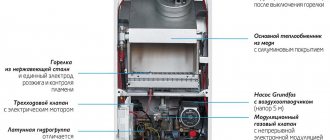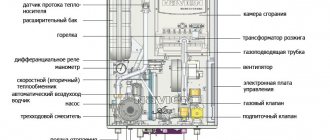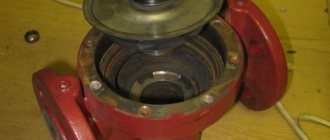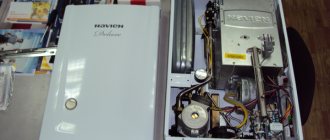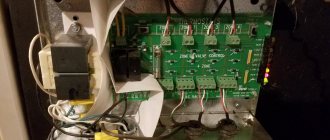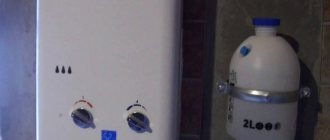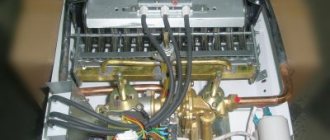The undoubted advantage of autonomous space heating systems over network resources is the ability to create a full-fledged heating circuit without reference to centralized mains.
Independence appears, there is no dependence on the tariffs and needs of resource suppliers.
All possible faults are located right here, inside the existing system, which allows you to quickly localize and eliminate detected problems.
Most of the problems that arise are related to the design of boilers, since the units are in a state of continuous operation, their main elements are subject to severe loads and significant wear.
Let's look at possible errors and malfunctions using the example of Baxi boilers, products of a well-known Italian company in Europe.
Malfunctions of Baksi gas boilers and their repair
The operation of any system is subject to many specific loads that arise both during normal operation and as a result of emerging malfunctions or failures of one or another element.
Among the many possible malfunctions, the most characteristic malfunctions that occur more often than others can always be identified.
For Baksi boilers, these include the following problems::
- Starting the gas burner is difficult or impossible.
- The boiler cannot be started.
- Characteristic popping sounds inside the combustion chamber.
- Installation overheating.
- The coolant temperature is too low.
- Extraneous sounds and noises heard during operation of the unit.
- Failure of any sensor.
The causes of the most common problems have been studied quite well, which allows us to list them with a high degree of confidence:
- Moisture (condensation) gets on the control board or other parts of the boiler.
- Low quality coolant (excessive hardness, formation of lime deposits).
- A drop or surge in gas pressure in the network.
- Voltage drop in the network, incorrect connection of the phase wire.
- Errors made during installation or commissioning.
In addition to the listed reasons, which occur most often, other, less common factors can affect the operation of the boiler.
For example, it is possible that one or another component of the system may fail, mechanical failure of parts, or destruction of the weakest elements of the system . Most of these situations are detected automatically and are the task of the self-diagnosis system.
Cleaning the primary and secondary heat exchangers
First, you need to remove water from the heating device. There is a tap on the right side of the boiler; if you unscrew it, the liquid will be drained. It would also be a good idea to drain the heating system. For cleaning, a special washing device is used. The pipes are connected to the pipes of the gas boiler. Then the cap on the flushing device is unscrewed, and then the cleaning liquid must be poured inside. After this, you can connect the device to the network.
Cleaning the heat exchanger is a slow process and can take several hours.
During this time, it is necessary to switch the direction of the rinsing fluid. After two to three hours, you should stop cleaning. After this, the tap is opened and the water is drained, and then the hoses are removed. When doing this, you need to be sure that all the liquid has flowed into the device. After all the manipulations, the boiler is reconnected to the heating system. The pipes are filled with coolant. Washing the device parts should dissolve the scale, which will increase the life of the system and optimize its operation.
Similar to the primary one, to clean the secondary heat exchanger, you need to attach a flushing device to the boiler. After connecting it to the network, you need to close the gas tap and move the hot water tap to the open position. Then turn on the cleaning device so that the reagent moves along a short circuit.
To install Baksi gas equipment, you should definitely use the services of gas service workers. They will also help in case of a malfunction in the boiler. Parts of heating devices from this company can also wear out over time, so sooner or later repairs will still be inevitable.
How to run self-diagnosis
A special launch of self-diagnosis of the Baxi boiler is impossible, since this system turns on immediately with the unit and operates in continuous mode. The system is formed by a network of sensors located in all main components of the boiler.
They constantly monitor the situation and give a signal immediately if any failures or failures of any element occur . It is sent to the control board, which reacts to changes in sensor readings by generating an error code displayed on the boiler display and blocks the operation of the device until the problem is resolved.
IMPORTANT!
The presence of a self-diagnosis system is a great advantage of the equipment, since it makes it possible to avoid serious accidents, allowing you to protect an expensive installation from destruction or failure. The owner of the installation is spared the need to constantly check the condition of the boiler; smart and advanced automation does everything for him .
What could be the reasons for the appearance of error E00 on a baxi boiler?
Incorrect operating conditions for power supply: absence of a stabilizer, or its malfunction, problems with grounding. Failure of the electronic board logic, which in turn can be caused by the reasons described in the previous paragraph. To understand, you need to check the operating conditions of the boiler and the serviceability of the electronic board (for example, by replacing it with a working one).
If, nevertheless, the cause of error e00
There is a board on the baxi boiler, diagnostics will be required to identify the faulty component.
Basic error codes and their interpretation
The list of standard errors that are displayed on the display in the form of an alphanumeric code is quite large.
For convenience, we present it in the form of a table:
| Error code | Decoding (problematic element) |
| E00 | Control board fault |
| E01 | Flame sensor failure |
| E02 | Overheat thermostat |
| E03 | Draft sensor on pneumatic relay or thermostat |
| E04 | Combustion mode control electrode |
| E05 | Exhaust temperature sensor |
| E06 | DHW temperature sensor |
| E09 | Control board fault |
| E10 | Pressure switch or pump operation sensor (pressostat) |
| E12 - 13 | Hydraulic pressure switch |
| E21 | Damage to control board elements |
| E22 | Low supply voltage |
| E25 - 26 | Coolant temperature sensor |
| E31 | There is no connection between the control board and the remote control |
| E32 | DHW and OB temperature sensors |
| E35 | Flame sensor |
| E40 - 41 | Combustion product pressure sensor (draft presence sensor) |
| E42 | Flame sensor |
| E97, 98, 99 | Malfunction of the electronic control board |
The appearance of a particular code is not always able to tell an unprepared person anything. A list of errors with explanations is available in the user manual, which should be kept at hand to quickly determine the causes or source of the malfunction.
NOTE!
Eliminating errors can be done independently, but in most cases the participation of a specialist from the service center is required. It is especially important to involve it during the warranty period.
Elimination
Let's look at possible problems and what needs to be done to fix them:
E 00
This error indicates a problem with the control board. The issue can only be resolved by the service center employees, since there can be many reasons and possible consequences of the intervention.
E 01
No ignition (no flame). The reason may be either a lack of gas in the line or a failure of the ignition system.
The solution to the problem is step-by-step - first checking the presence of gas, then examining the condition of the gas equipment, checking the ignition system, etc. This error occurs most often, since there can be quite a few reasons for its occurrence.
Solving the problem on your own is not recommended; it is better to invite a specialist.
E 03
The cause may equally be a clogged chimney and a lack of contact between the fan and the control board.
It is recommended to examine both positions and carry out work on both the chimney and the contact group of the fan (pressostat).
E 05 - 06
A failure in the operation of these sensors indicates a failure of either the elements themselves or a failure of contact with the control board.
First of all, you need to check the temperature of the extract air and hot water supply to determine whether the sensor readings are generally true.
Then contacts with the control board should be restored. If a positive result cannot be achieved, the sensors need to be replaced .
E 10
A drop in water pressure indicates leaks. It is necessary to inspect the heating circuit and check the boiler drain valve.
If no problems are found in them, you should check the sensor contacts . If necessary, it is changed.
E 25
A sharp increase in the temperature of the OM indicates a lack of circulation. The most likely reason for this is airing of the heating circuit elements. The solution to the problem will be to bleed air from the system . If this does not help, the sensor must be replaced.
E 35
The signal about the appearance of a parasitic flame indicates either a short circuit of the sensor contacts due to the appearance of drops of water (condensation) on the board, a breakdown through a layer of soot, or other similar situations.
The solution to the problem will be to clean the board, install high-quality grounding and additional insulation on the contact group of the sensor.
E 98 - 99
This error indicates a failure of the control board for unknown reasons. The solution to the problem must be entrusted to a specialist; correcting the situation on your own is unacceptable.
How pressure drops in the boiler
A drop in pressure in the boiler can be caused by a single reason - a coolant leak.
If recharging the system does not have a long-term effect, it means there is a leak somewhere in the circuit. Alternatively, there is a malfunction of the drain valve through which water goes into the sewer.
The solution to the issue will be to restore the tightness of pipelines, radiators and system connections.
In addition, it is necessary to inspect the drain valve, heat exchanger, three-way valve and other boiler elements involved in the movement of the heating agent.
Flame control sensor fault (baxi e01)
In general, some manufacturers claim that the “igniter” is a consumable item. Personally, I have a baxi eco four boiler in my apartment and I have never changed it (the boiler is already six years old). But nevertheless, everything depends on the specific operating conditions, gas quality and air pollution. Therefore, you need to carry out an inspection, if necessary, clean the electrode with an alcohol solution and check its correct position and gap relative to the burner body according to the instructions (this may be different for different models). Case from practice: a client complains about the Baxi boiler error E01. We changed the board - the boiler worked for a day and again the same error. What did you do with the boiler before the error appeared? We bent the electrode and made a gap of 1 mm. On what basis? Somewhere someone told, showed...
In Baxi boilers, the ignition electrode also performs the function of flame control. Flame control is one of the most important functions of the boiler safety system. It is needed so that the boiler immediately shuts off the gas supply if the flame on the burner goes out for some reason. The gap must be set exactly as specified in the operating manual for the device!
The fact is that the principle of flame control is to register a small current that begins to flow through the electrode during combustion. And the flame structure has an air gap at the base, and if the gap is too small, the flame will not be registered and the boiler will fail when operating at certain power modes.
We do not recommend bending the electrode under any circumstances - it is very fragile and will most likely break off.
As an option, carefully bend the attachment point.
Why doesn't the device restart?
Failure to restart usually indicates the presence of air in the system or internal elements of the boiler.
The solution to the issue may be to bleed air from the circulation pump, which is done by loosening the central screw of the device . The air will hiss out, and when water comes out, you need to tighten the screw again until the coolant stops escaping. After this, restart the boiler.
Doesn't light up right away
The cause of delayed ignition may be incorrect information supplied by the extract air or DHW temperature sensor.
If it gives a signal about the high temperature of these liquids, the command to ignite the burner will not work.
You can check the correct operation of the sensor by disconnecting the contacts from the control board.
If after this ignition occurs as expected, then the reason is in the sensor. If the situation has not changed, the search for a solution should be carried out in the ignition equipment itself. Alternatively, condensation may accumulate in the air sensor tubes. They need to be blown out, after which the burner will start in normal mode.
Operating principle
The combustion chamber of baxi boilers is made of metal. The outside is covered with a layer of thermal insulation. A copper heat exchanger is placed above the combustion chamber, and the burner is located under the combustion chamber.
When the air temperature in the room changes, the thermostat automatically starts, transmitting a switching signal to the pump, which creates a vacuum in the return pipeline. In this case, heated water begins to flow into the supply line of the heating system under a pressure of no more than 0.45 bar (if the pressure increases, the microprocessor sends a signal to the relay, the contacts close, and the burner ignites). The boiler starts with low power, which gradually increases until the coolant temperature reaches the set temperature. After this, the heating mode changes to modulation mode. As soon as the coolant temperature deviates from the set value towards a decrease, a signal is received from the temperature sensor, the fuel inlet valve opens, the burner is re-ignited and heats the water.
If at the beginning of operation the boiler power is too high, the burner automatically turns off and the system can be restarted only after three minutes.
When there is no need for heating, the boiler is switched on to DHW mode. In this case, cold water enters the secondary circuit through a three-way valve that shuts off the heating line. Fuel flows from the gas valve into the burner, gradually increasing power. When the water heats up, the temperature control mode is activated.
Valve clicks
Gas valve clicks can be observed for various reasons - from a weak contact on the relay, to a difference in gas pressure in the main line and the boiler valve system. In each case, solving the problem requires its own actions.
Restore the gas valve relay contact group, adjust the minimum and maximum gas pressure, check the inlet reducer setting. All this work must be carried out by specialists from the service center; it is extremely dangerous to interfere with the operation of gas equipment on your own .
